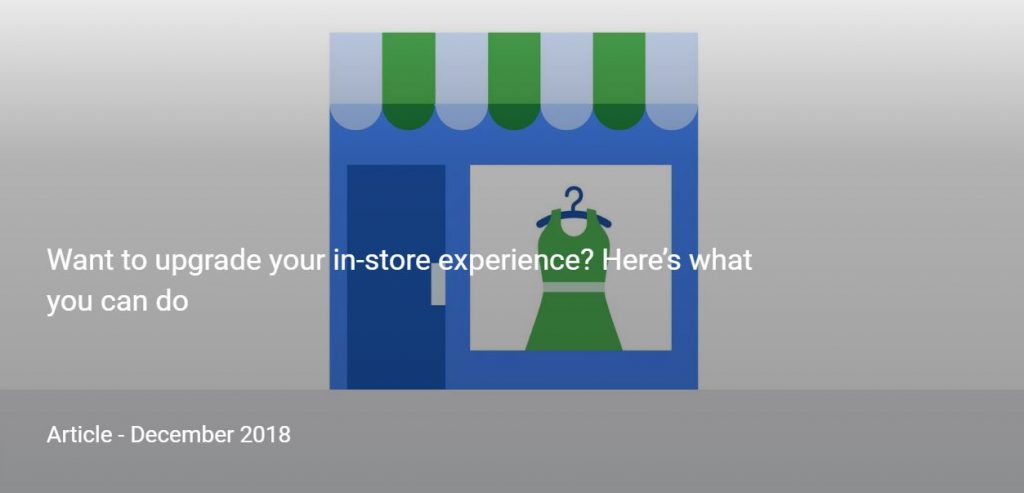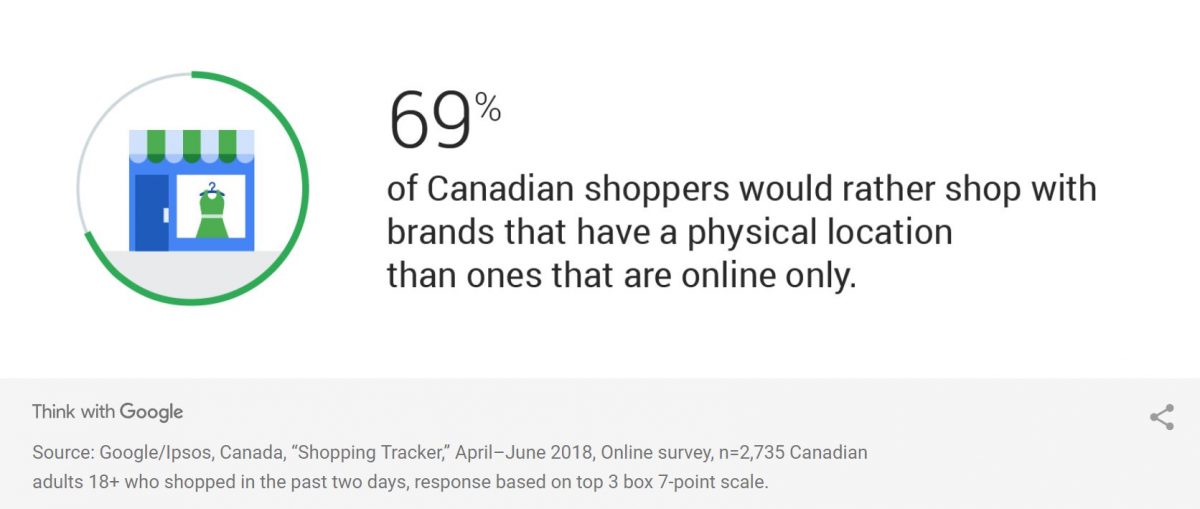
Want to upgrade your in-store experience? Here’s what you can do
With the holidays fast approaching, online shopping is top of mind for many people. In fact, more than a third of Canadians say they’d do all of their holiday shopping online if they could.1
While the convenience of shopping from home can be hard to beat, leading marketers aren’t giving up on their in-store shopping locations — and for good reason: 69% of Canadian shoppers would rather shop at retailers/stores that also have a physical location than ones that are online only.2 Plus, demand for local information continues to surge. Compared to 2015, “near me” searches in Canada grew over 700%.3

It’s clear people still want to shop in stores. So how can brands keep customers coming back? Here are a few ways to ensure your physical locations remain crucial assets for your business.
Embrace the convenience that online can’t match
For impatient shoppers, stores still rule. Eighty-six percent of Canadian shoppers will go in-store when it has an item they want immediately.4 The familiarity and comfort of going back to the same place are also key for shoppers. Research tells us that 41% of Canadians who purchased in-store said they did so because it’s where they always buy.5 Still, leading marketers aren’t resting on their laurels; they’re finding new ways to make sure shoppers can quickly get what they need.
Create unique, hands-on opportunities to engage with products
Another thing shoppers appreciate? The ability to experience products in person. There are two attributes people value that are distinctive to shopping in stores: seeing and interacting with a product before buying it. Thirty-six percent of Canadian shoppers also say they choose to go to a store because it’s more fun than shopping online.6
That’s why leading marketers are doubling down when it comes to creating unique, enjoyable experiences for shoppers who walk through their doors. Canada Goose is one brand creating “can’t find this anywhere else” experiences in its stores. Knowing that customers have trouble choosing the right coat to keep them warm in the harshest elements, the brand has launched Cold Rooms in its Montreal, Hong Kong, New Jersey, and Boston stores that allow people to try on parkas at temperatures as low as −25°C. Inspired by cold conditions in places like Churchill, Manitoba, best known for its polar bear population, the Cold Room includes an adjustable thermometer and a Wind Chill switch that can be turned on and off to enhance the elements. This gives customers the opportunity to try a wide range of products and really test them in the environments the brand has been built on.
Bring the best of online and offline together
Whether it’s a digital cart or a physical one, brands must be there to help customers feel good about their purchase. To help achieve that, ensure your channels work together.
Retailers like Sephora are investing in digital technologies that serve as personal shopping assistants while customers are in stores. The brand’s mobile app makes it easy for shoppers to scan barcodes to read product reviews, look up their order history, and more.
The Sephora Virtual Artist feature within the app also encourages product exploration, including the ability to test full-face looks using facial recognition and augmented reality technologies. Customers can virtually try on thousands of makeup shades across lip, shadow, eyeliner, lash, cheek, and brow categories. And new features like Snap & Try let people try on anyone’s look, including friends and celebrities, while Foundation Finder helps shoppers find the right foundation for their skin tone.
Is your store making products easy to find and readily available? If not, the next retailer or brand is just a mobile search away.
3 questions to ask yourself
With online shopping quickly closing the gap on the speed and service offered by stores, retailers and brands must reimagine the experiences they deliver to add unique value that can’t be found on digital channels alone. Ask yourself:
- Is your store making products easy to find and readily available? If not, the next retailer or brand is just a mobile search away.
- Is it worth the trip? Traveling to a store isn’t always convenient, so help your store stand out by offering interesting experiences and valuable expertise.
- How does your store complement your website? Be there for customers no matter where they are by designing experiences that harness the unique benefits of both online and offline channels.

Sources (6)
1 Google/Ipsos, “Omnichannel Holiday Study,” Nov. 2017–Jan. 2018, Canada, n=2,711 holiday shoppers 18+ who shopped in previous 48 hours.
2 Google/Ipsos, Canada, “Shopping Tracker,” April–June 2018, Online survey, n=2,735 Canadian adults 18+ who shopped in the past two days, response based on top 3 box 7-point scale.
3 Google Data, Canada, July–Dec. 2015 vs. July–Dec. 2017.
4 Google/Ipsos, “Shopping Tracker,” Oct.–Dec. 2017, Canada, Online survey, n=3,618 online Canadians 13+ who shopped in the past two days.
5 Google/Ipsos, “Fall Shopping”, Aug.–Sept. 2017, Canada, Online survey, n=1,158 Canadians 18+ in-store purchasers.
6 Google/Ipsos, “Omnichannel Holiday Study,” Nov. 2017–Jan. 2018, Canada, n=543 holiday shoppers who visited a store in the past 48 hours.
